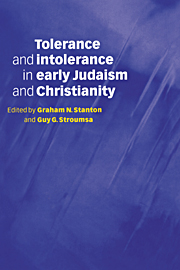Book contents
- Frontmatter
- Contents
- List of contributors
- List of abbreviations
- Introduction
- 1 Intolerance and martyrdom: from Socrates to Rabbi ‘Aqiva
- 2 The other in 1 and 2 Maccabees
- 3 The pursuit of the millennium in early Judaism
- 4 Conservative revolution? The intolerant innovations of Qumran
- 5 Who was considered an apostate in the Jewish Diaspora?
- 6 Why did Paul persecute the church?
- 7 Paul and the limits of tolerance
- 8 Philo's views on paganism
- 9 Coexisting with the enemy: Jews and pagans in the Mishnah
- 10 Tertullian on idolatry and the limits of tolerance
- 11 The threefold Christian anti-Judaism
- 12 The intertextual polemic of the Markan vineyard parable
- 13 Jews and Jewish Christians in the land of Israel at the time of the Bar Kochba war, with special reference to the Apocalypse of Peter
- 14 The Nazoreans: living at the boundary of Judaism and Christianity
- 15 Justin Martyr's Dialogue with Trypho: group boundaries, ‘proselytes’ and ‘God-fearers’
- 16 Accusations of Jewish persecution in early Christian sources, with particular reference to Justin Martyr and the Martyrdom of Polycarp
- 17 Early Christians on synagogue prayer and imprecation
- 18 Messianism, Torah and early Christian tradition
- 19 Jewish and Christian public ethics in the early Roman Empire
- Postscript: the future of intolerance
- General bibliography
- Index
15 - Justin Martyr's Dialogue with Trypho: group boundaries, ‘proselytes’ and ‘God-fearers’
Published online by Cambridge University Press: 08 March 2010
- Frontmatter
- Contents
- List of contributors
- List of abbreviations
- Introduction
- 1 Intolerance and martyrdom: from Socrates to Rabbi ‘Aqiva
- 2 The other in 1 and 2 Maccabees
- 3 The pursuit of the millennium in early Judaism
- 4 Conservative revolution? The intolerant innovations of Qumran
- 5 Who was considered an apostate in the Jewish Diaspora?
- 6 Why did Paul persecute the church?
- 7 Paul and the limits of tolerance
- 8 Philo's views on paganism
- 9 Coexisting with the enemy: Jews and pagans in the Mishnah
- 10 Tertullian on idolatry and the limits of tolerance
- 11 The threefold Christian anti-Judaism
- 12 The intertextual polemic of the Markan vineyard parable
- 13 Jews and Jewish Christians in the land of Israel at the time of the Bar Kochba war, with special reference to the Apocalypse of Peter
- 14 The Nazoreans: living at the boundary of Judaism and Christianity
- 15 Justin Martyr's Dialogue with Trypho: group boundaries, ‘proselytes’ and ‘God-fearers’
- 16 Accusations of Jewish persecution in early Christian sources, with particular reference to Justin Martyr and the Martyrdom of Polycarp
- 17 Early Christians on synagogue prayer and imprecation
- 18 Messianism, Torah and early Christian tradition
- 19 Jewish and Christian public ethics in the early Roman Empire
- Postscript: the future of intolerance
- General bibliography
- Index
Summary
Justin's Dialogue is the earliest surviving writing which sets out fully the issues which separated Christians and Jews. This fascinating Dialogue was written about 160 GE. It draws on earlier Christian exegetical traditions; in places it has very deep roots in Jewish–Christian polemic and apologetic.
Although Justin and Trypho argue vigorously, they do not resort to personal abuse or to name-calling. At the end of the Dialogue, they agree to disagree; after praying for one another they go their separate ways. Most later Christian anti-Jewish writings are less moderate in tone; unlike Trypho, the Jewish opponent(s) often cave in and accept the ‘truth’ of Christianity. However, if we have twentieth-century understandings of ‘tolerance’ in mind, it would not be appropriate to claim either Justin or Trypho as models of ‘tolerance’. Both the Christian and his Jewish partner in dialogue not only set out their respective very different religious positions, they go further: they appeal vigorously to one another to change sides, with the clear implication that the other side is wrong-headed.
How plausible is Justin's claim that his Dialogue records an extended discussion he had with a learned Jew, Trypho, shortly after the second Jewish revolt? Opinions have differed widely. My own view is that the Dialogue is neither a verbatim account of a two-day debate which took place in Ephesus between a Christian and a Jew, nor a wholly artificial compilation of Christian polemical traditions which is unrelated to discussions between Christians and Jews in the middle decades of the second century.
- Type
- Chapter
- Information
- Tolerance and Intolerance in Early Judaism and Christianity , pp. 263 - 278Publisher: Cambridge University PressPrint publication year: 1998
- 2
- Cited by



